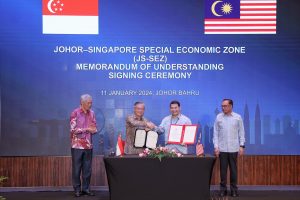Malaysia and Singapore have agreed jointly to develop a special economic zone in the southern Malaysian state of Johor, with the aim of attracting investment and increasing the movement of goods and people across their shared border.
In a ceremony yesterday, Economy Minister Rafizi Ramli and Singapore’s Trade and Industry Minister Gan Kim Yong signed a memorandum of understanding on the Johor-Singapore Special Economic Zone (JS-SEZ). In a subsequent joint statement, the two sides said that they would work towards establishing a complete agreement during their 11th Leaders Retreat later this year.
“Under the MoU, Malaysia and Singapore will work towards enhancing cross-border flows of goods and people as well as strengthen the business ecosystem within SEZ to support investments,” they said in the statement. “The SEZ rides on the strong growth of Johor and significant investments in the region by Singapore.”
Malaysia’s Economy Minister Rafizi Ramli said that the JS-SEZ “presents an unprecedented opportunity” for both nations to enhance the degree of crossborder trade and movement.
According to the joint statement, Singapore and Malaysia are also exploring other initiatives that will “build towards” the JS-SEZ, including a passport-free clearance system on both sides of the border and possible renewable energy cooperation.
The signing of the MOU came shortly after Singapore’s Prime Minister Lee Hsien Loong and Malaysian Prime Minister Anwar Ibrahim witnessed the completion of the first connecting span of the light rail (or RTS) link connecting Singapore and Johor’s state capital Johor Bahru.
According to Singapore’s Ministry of Foreign Affairs, the 4-kilometer link will connect Bukit Chagar station in Johor Bahru with the Woodlands North station in Singapore. It will have a peak capacity of up to 10,000 passengers per hour in each direction, and is designed to ease traffic congestion on the Johor-Singapore Causeway, one of the world’s busiest land crossings. The RTS, which cost an estimated, 10 billion ringgit ($2.2 billion), is expected to commence passenger service at the end of 2026.
The rail link is just the latest upgrade to the Causeway, which was constructed in 1924 and has been widened and expanded numerous times in the years since.
In a post on Facebook, Prime Minister Lee Hsien Loong wrote that the link “brings our friendship and bilateral ties closer.” He added that the RTS and JS-SEZ would “enhance cross-border links, support businesses, and create jobs on both sides of the Causeway.”
Both agreements are aimed at tightening the already close economic interdependence between Singapore and peninsular Malaya, with which the Lion City was united briefly before its expulsion from the Malaysian Federation in 1965. The border between the two nations is one of the busiest in the world, with more than 350,000 people commuting from Malaysia to Singapore across the Johor-Singapore Causeway each day.
Malaysia and Singapore have also discussed the construction of a 350-kilometer high-speed railway connecting Singapore and Kuala Lumpur. The project was first announced in 2013, but was eventually terminated in 2020 due to disagreements and funding constraints on the Malaysian side. Recent months have brought reports that Anwar’s government may be interested in reviving the project, if the cost can be substantially lowered.

































